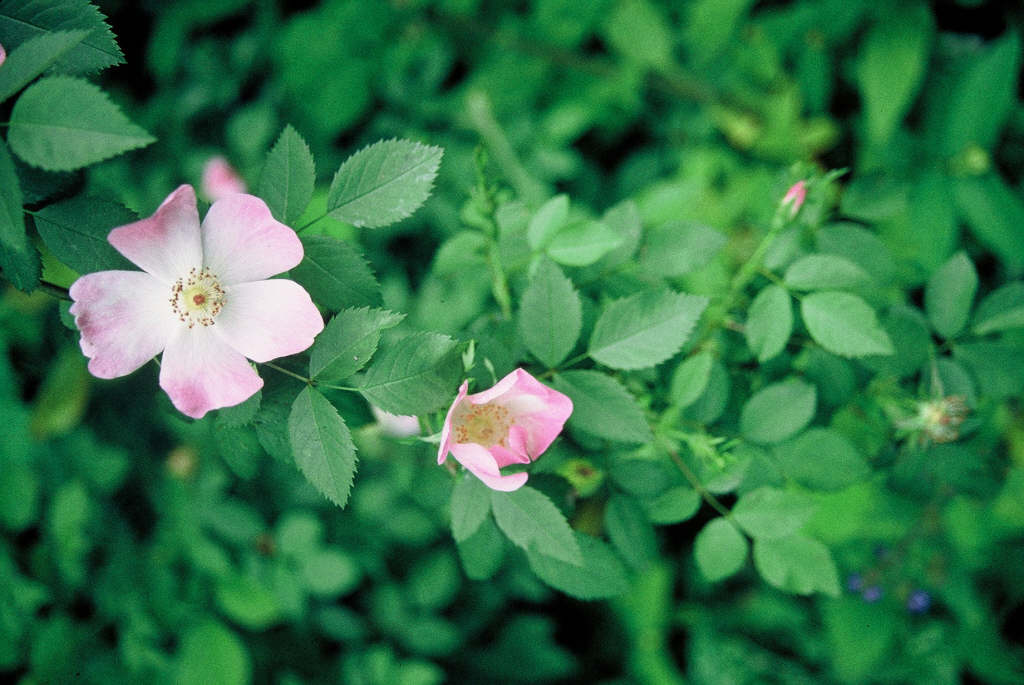Rosa canina (S)
dog rose
A vigorous arching deciduous shrub about 3m in height, with strong prickly stems bearing mid-green foliage and fragrant, single, pale pink or white flowers 5cm across, with prominent yellow stamens, produced either solitary or in small clusters, in early summer, followed by ovoid red fruits
Other common names
bird briarbriar rose
see morebuckieberries
canker
canker flower
canker rose
cankerberry
choop tree
common brier
dog briar
dog brier
hep briar
hep rose
hep tree
wild rose
cat whin
rhosyn gwyllt
Synonyms
Rosa psilophyllaRosa cladoleia
see moreRosa glaucescens
Rosa spuria
Rosa villosiucula
Rosa firma
Rosa montivaga
Rosa condensata
Size
Ultimate height
2.5–4 metresTime to ultimate height
5–10 yearsUltimate spread
1.5–2.5 metresGrowing conditions
Moisture
Moist but well–drained, Well–drainedpH
Acid, Alkaline, NeutralColour & scent
| Stem | Flower | Foliage | Fruit | |
| Spring | Green | |||
|---|---|---|---|---|
| Summer | Pink White | Green | ||
| Autumn | Green | Red | ||
| Winter |
Position
- Full sun
- Partial shade
Aspect
South–facing or North–facing or East–facing or West–facing
Exposure
Exposed or Sheltered Hardiness
H7Botanical details
- Family
- Rosaceae
- Native to GB / Ireland
- Yes
- Foliage
- Deciduous
- Habit
- Spreading branched
- Potentially harmful
- Fruit are ornamental - not to be eaten. Wear gloves and other protective equipment when handling. Pets: Fruit are ornamental - not to be eaten - see the HTA guide to potentially harmful plants for further information and useful contact numbers
- Genus
Rosa can be deciduous or semi-evergreen shrubs or scrambling climbers, with usually thorny stems bearing compound pinnate leaves and solitary or clustered flowers. Flowers may be followed by showy red or purple fruits in some varieties.
- Name status
Correct
- Horticultural Group
- Shrub roses are large shrubs with usually thorny stems bearing large leaves and fragrant, single to double flowers in clusters in summer, and usually also in autumn
- Plant range
- Europe, N Africa, SW Asia
How to grow
Cultivation
'Dog Rose', a wild rose native to Britain with abundant orange-red hips in autumn. Grow in full sun or part shade in moderately fertile, humus-rich, moist but well-drained soil. For best flowering apply a balanced fertiliser and mulch in late winter or early spring. Tolerant of poor soil and north-facing locations. See rose cultivation for further advice
Propagation
Propagate by softwood cuttings in early to mid spring, hardwood cuttings in late summer to autumn or by chip budding in summer; propagate by seed; species roses can be propagated by seed but need stratification and germination may take two seasons
Suggested planting locations and garden types
- Wildlife gardens
- Wildflower meadow
- Cottage and informal garden
- Flower borders and beds
Pruning
See pruning group 20 (roses)
Pests
May be susceptible to aphids, rose leafhopper, glasshouse red spider mite, scale insects, caterpillars, large rose sawfly, rose slugworm sawfly and rose leaf-rolling sawfly. Deer and rabbits can cause damage
Diseases
May be susceptible to rose black spot, rose rust, replant disease, rose dieback, and rose powdery mildew and sometimes honey fungus. May also be susceptible to disorder rose blindness
Get involved
The Royal Horticultural Society is the UK’s leading gardening charity. We aim to enrich everyone’s life through plants, and make the UK a greener and more beautiful place.
